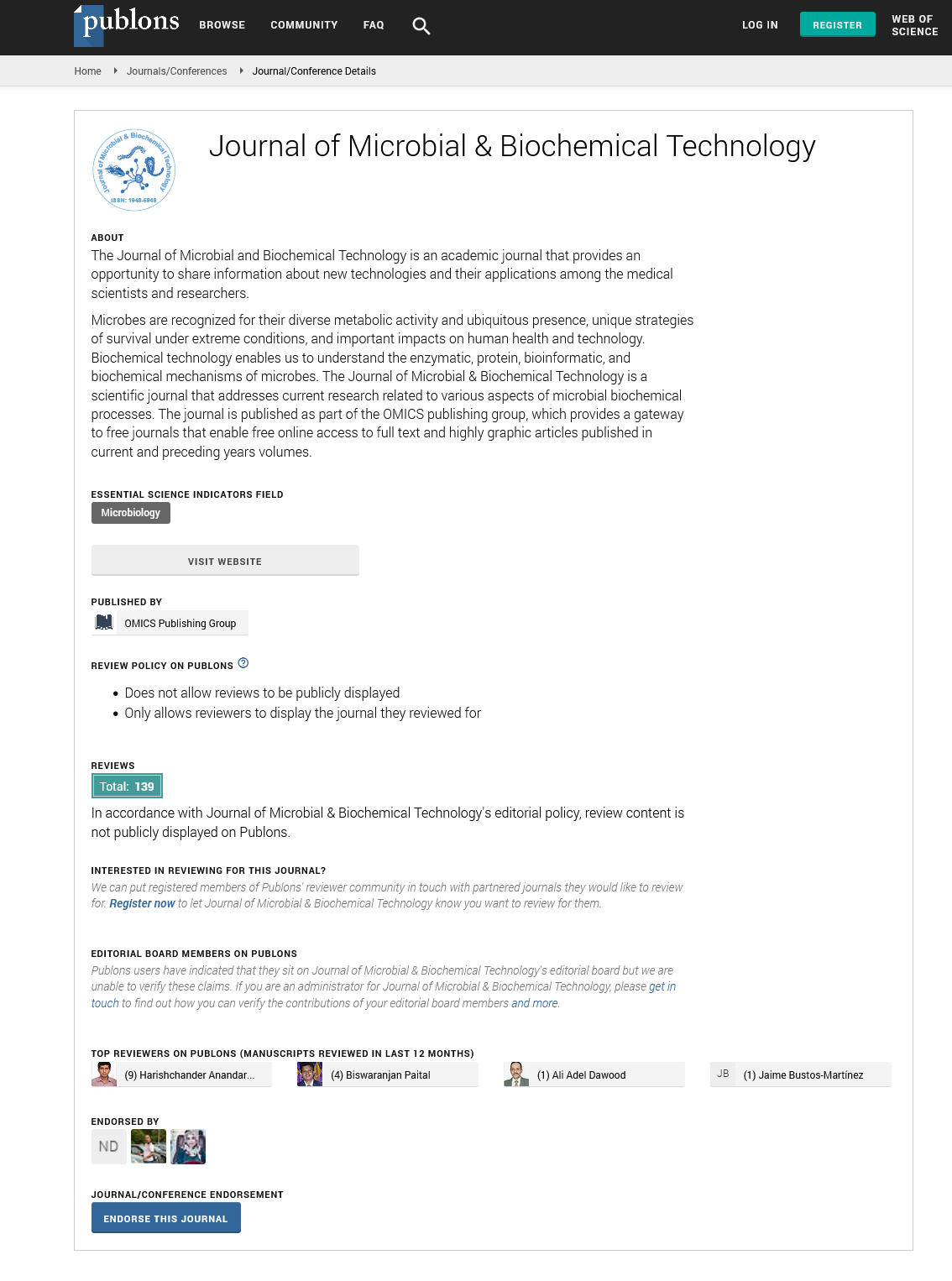Indexed In
- Academic Journals Database
- Genamics JournalSeek
- Academic Keys
- JournalTOCs
- China National Knowledge Infrastructure (CNKI)
- Scimago
- Access to Global Online Research in Agriculture (AGORA)
- Electronic Journals Library
- RefSeek
- Directory of Research Journal Indexing (DRJI)
- Hamdard University
- EBSCO A-Z
- OCLC- WorldCat
- SWB online catalog
- Virtual Library of Biology (vifabio)
- Publons
- MIAR
- University Grants Commission
- Geneva Foundation for Medical Education and Research
- Euro Pub
- Google Scholar
Useful Links
Share This Page
Journal Flyer

Open Access Journals
- Agri and Aquaculture
- Biochemistry
- Bioinformatics & Systems Biology
- Business & Management
- Chemistry
- Clinical Sciences
- Engineering
- Food & Nutrition
- General Science
- Genetics & Molecular Biology
- Immunology & Microbiology
- Medical Sciences
- Neuroscience & Psychology
- Nursing & Health Care
- Pharmaceutical Sciences
Short Communication - (2024) Volume 16, Issue 3
Bioremediation of Heavy Metal Contaminated Soils: Evaluating the Efficiency of Indigenous Microbial Strains
Khaled Almutairi*Received: 26-Aug-2024, Manuscript No. JMBT-24-27266; Editor assigned: 28-Aug-2024, Pre QC No. JMBT-24-27266; Reviewed: 11-Sep-2024, QC No. JMBT-24-27266; Revised: 17-Sep-2024, Manuscript No. JMBT-24-27266; Published: 25-Sep-2024, DOI: 10.35248/1948-5948.24.16.623
Description
Heavy metal contamination of soils has emerged as a significant environmental concern due to its detrimental effects on ecosystems, human health and agricultural productivity. The presence of heavy metals such as lead, cadmium, mercury and arsenic in soil is often a consequence of industrial activities, mining, agricultural practices and improper waste disposal. These metals are non-biodegradable, accumulate in the food chain and pose risks to both flora and fauna. Traditional remediation methods, such as excavation and landfilling, often prove to be costly and environmentally disruptive. Consequently, there is a pressing need for sustainable and eco-friendly strategies to mitigate heavy metal pollution. Bioremediation, utilizing the natural capabilities of microorganisms, has garnered attention as an innovative approach to restore contaminated soils.
Bioremediation is defined as the process of using living organisms, particularly microorganisms, to degrade, immobilize, or detoxify environmental contaminants. Among the various strategies of bioremediation, the use of indigenous microbial strains has been identified as a promising and effective method for the removal of heavy metals from contaminated soils. Indigenous microbes, which are native to a specific environment, possess unique adaptations that enable them to thrive in the presence of heavy metals. These adaptations often include the development of resistance mechanisms, metalbinding capabilities and metabolic pathways that facilitate the transformation or sequestration of heavy metals.
The efficiency of indigenous microbial strains in bioremediation is influenced by several factors, including the specific characteristics of the contaminated site, the types of heavy metals present and the microbial community structure. In contaminated soils, indigenous microorganisms exhibit diverse metabolic activities that can either facilitate the mobilization or immobilization of heavy metals. For example, some microbes can transform toxic metal ions into less toxic forms through processes such as reduction, oxidation, methylation, or complexation. Others can enhance the bioavailability of heavy metals, allowing for their uptake and subsequent detoxification. Furthermore, indigenous strains often establish symbiotic relationships with plants, enhancing phytoremediation efforts by improving metal uptake and tolerance.
Several studies have documented the successful application of indigenous microbial strains in the bioremediation of heavy metal-contaminated soils. For instance, researchers have isolated specific bacterial strains from contaminated sites that exhibit high levels of resistance to heavy metals. These strains can effectively reduce metal concentrations in soil through biosorption, where metal ions bind to microbial cell surfaces, or through bioaccumulation, where metals are taken up and stored within microbial cells. Additionally, the metabolic capabilities of indigenous strains can be harnessed to develop bioremediation strategies that are both efficient and cost-effective.
Moreover, the combination of indigenous microbial strains with other bioremediation techniques, such as phytoremediation or the application of biochar, has shown to enhance the overall effectiveness of heavy metal removal. For instance, the introduction of metal-resistant bacteria into the rhizosphere of metal-accumulating plants can significantly increase the rates of metal uptake and translocation. This synergistic approach not only improves metal removal efficiency but also promotes soil health and sustainability.
Despite the promising potential of indigenous microbial strains in bioremediation, several challenges remain. The effectiveness of bioremediation can be influenced by environmental factors such as soil pH, moisture content and temperature. Additionally, the complexity of soil microbial communities and the interactions between different microbial species can complicate the implementation of bioremediation strategies. Understanding these interactions and optimizing environmental conditions are critical for enhancing the performance of indigenous strains in heavy metal remediation.
In conclusion, the bioremediation of heavy metal-contaminated soils using indigenous microbial strains represents a sustainable and effective solution to address environmental contamination. The natural adaptability and metabolic diversity of indigenous microorganisms provide a unique advantage in the degradation and detoxification of heavy metals. As research continues to uncover the mechanisms underlying microbial interactions and adaptations in contaminated environments, the development of tailored bioremediation strategies will become increasingly feasible. Ultimately, leveraging the capabilities of indigenous microbial strains holds the potential not only to remediate contaminated soils but also to restore ecological balance and promote environmental health. This approach not only mitigates the risks associated with heavy metal pollution but also contributes to the sustainability of agricultural practices and the protection of human health in contaminated areas.
Citation: Almutairi K (2024). Bioremediation of Heavy Metal Contaminated Soils: Evaluating the Efficiency of Indigenous Microbial Strains. J Microb Biochem Technol. 16:623.
Copyright: © 2024 Almutairi K. This is an open access article distributed under the terms of the Creative Commons Attribution License, which permits unrestricted use, distribution, and reproduction in any medium, provided the original author and source are credited.

